English Legal System: Doctrine of Precedent and its Principles
VerifiedAdded on 2020/06/04
|7
|2642
|49
Report
AI Summary
This report examines the Doctrine of Precedent within the English Legal System, detailing its role in shaping legal decisions through common law. It explores the principles of precedent, including ratio decidendi and obiter dicta, and their application in case law such as Donoghue v Stevenson and Grant v Australian Knitting Mills Ltd. The report discusses the hierarchy of courts, including the House of Lords and Court of Appeal, and their functions in establishing and modifying legal precedents. It further analyzes the roles of policy, legislation, and the Limitation Act 1980, highlighting how they impact the legal framework. The report also covers the concepts of reversing and overruling, and the application of the doctrine in various legal scenarios. The report emphasizes the significance of judges' roles in interpreting and applying laws to meet societal challenges, and the importance of setting effective rules and policies for the benefit of the people.
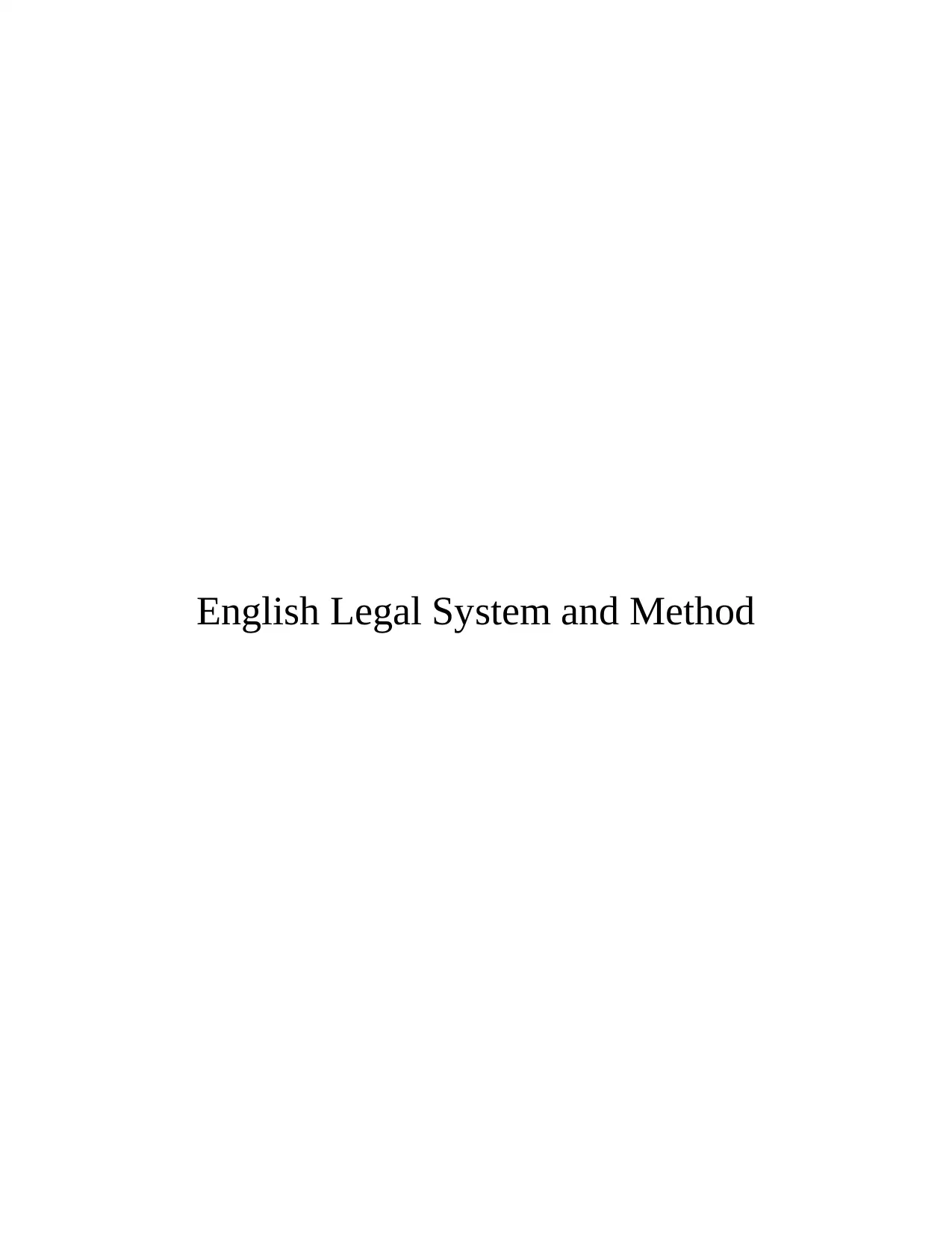
English Legal System and Method
Paraphrase This Document
Need a fresh take? Get an instant paraphrase of this document with our AI Paraphraser
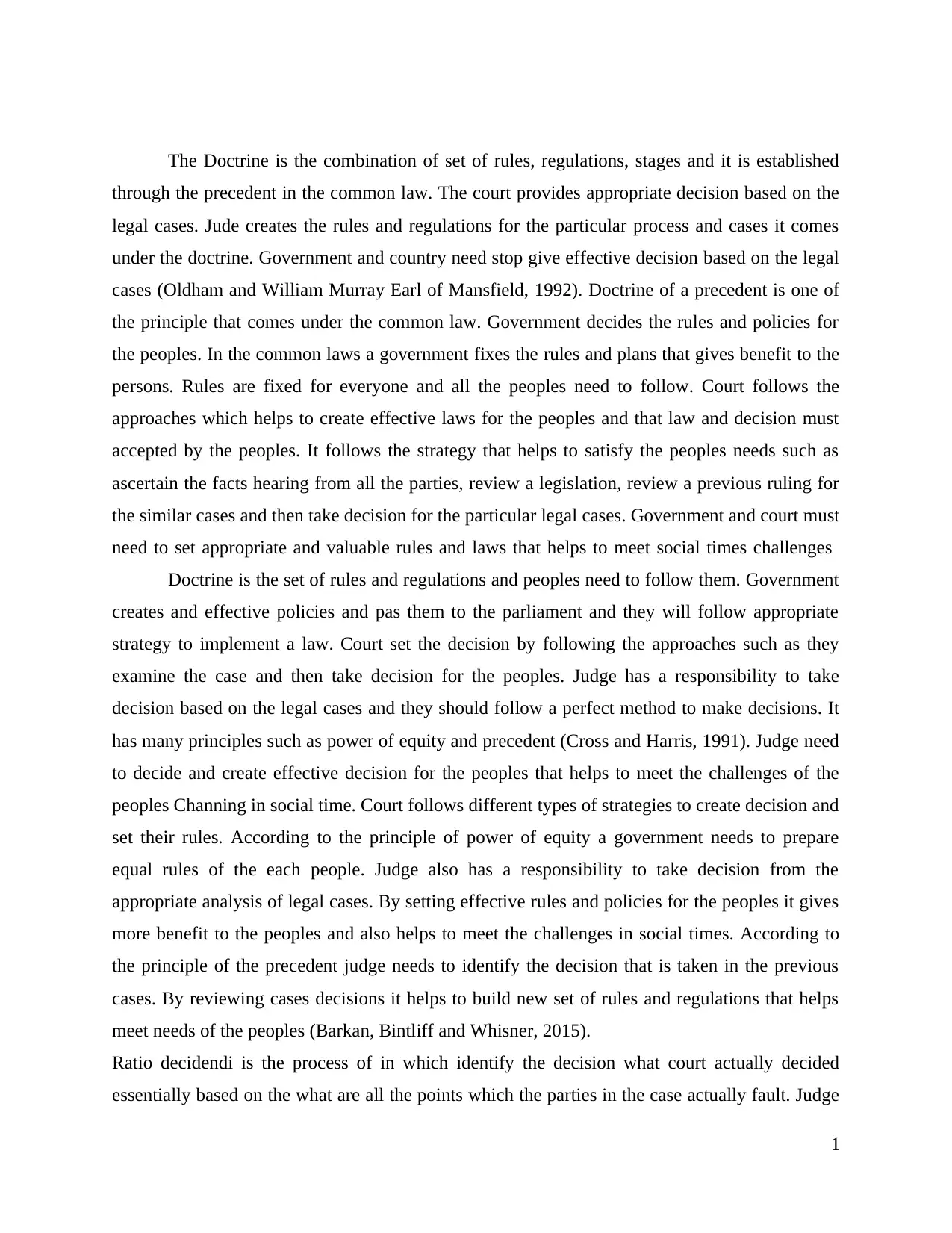
The Doctrine is the combination of set of rules, regulations, stages and it is established
through the precedent in the common law. The court provides appropriate decision based on the
legal cases. Jude creates the rules and regulations for the particular process and cases it comes
under the doctrine. Government and country need stop give effective decision based on the legal
cases (Oldham and William Murray Earl of Mansfield, 1992). Doctrine of a precedent is one of
the principle that comes under the common law. Government decides the rules and policies for
the peoples. In the common laws a government fixes the rules and plans that gives benefit to the
persons. Rules are fixed for everyone and all the peoples need to follow. Court follows the
approaches which helps to create effective laws for the peoples and that law and decision must
accepted by the peoples. It follows the strategy that helps to satisfy the peoples needs such as
ascertain the facts hearing from all the parties, review a legislation, review a previous ruling for
the similar cases and then take decision for the particular legal cases. Government and court must
need to set appropriate and valuable rules and laws that helps to meet social times challenges
Doctrine is the set of rules and regulations and peoples need to follow them. Government
creates and effective policies and pas them to the parliament and they will follow appropriate
strategy to implement a law. Court set the decision by following the approaches such as they
examine the case and then take decision for the peoples. Judge has a responsibility to take
decision based on the legal cases and they should follow a perfect method to make decisions. It
has many principles such as power of equity and precedent (Cross and Harris, 1991). Judge need
to decide and create effective decision for the peoples that helps to meet the challenges of the
peoples Channing in social time. Court follows different types of strategies to create decision and
set their rules. According to the principle of power of equity a government needs to prepare
equal rules of the each people. Judge also has a responsibility to take decision from the
appropriate analysis of legal cases. By setting effective rules and policies for the peoples it gives
more benefit to the peoples and also helps to meet the challenges in social times. According to
the principle of the precedent judge needs to identify the decision that is taken in the previous
cases. By reviewing cases decisions it helps to build new set of rules and regulations that helps
meet needs of the peoples (Barkan, Bintliff and Whisner, 2015).
Ratio decidendi is the process of in which identify the decision what court actually decided
essentially based on the what are all the points which the parties in the case actually fault. Judge
1
through the precedent in the common law. The court provides appropriate decision based on the
legal cases. Jude creates the rules and regulations for the particular process and cases it comes
under the doctrine. Government and country need stop give effective decision based on the legal
cases (Oldham and William Murray Earl of Mansfield, 1992). Doctrine of a precedent is one of
the principle that comes under the common law. Government decides the rules and policies for
the peoples. In the common laws a government fixes the rules and plans that gives benefit to the
persons. Rules are fixed for everyone and all the peoples need to follow. Court follows the
approaches which helps to create effective laws for the peoples and that law and decision must
accepted by the peoples. It follows the strategy that helps to satisfy the peoples needs such as
ascertain the facts hearing from all the parties, review a legislation, review a previous ruling for
the similar cases and then take decision for the particular legal cases. Government and court must
need to set appropriate and valuable rules and laws that helps to meet social times challenges
Doctrine is the set of rules and regulations and peoples need to follow them. Government
creates and effective policies and pas them to the parliament and they will follow appropriate
strategy to implement a law. Court set the decision by following the approaches such as they
examine the case and then take decision for the peoples. Judge has a responsibility to take
decision based on the legal cases and they should follow a perfect method to make decisions. It
has many principles such as power of equity and precedent (Cross and Harris, 1991). Judge need
to decide and create effective decision for the peoples that helps to meet the challenges of the
peoples Channing in social time. Court follows different types of strategies to create decision and
set their rules. According to the principle of power of equity a government needs to prepare
equal rules of the each people. Judge also has a responsibility to take decision from the
appropriate analysis of legal cases. By setting effective rules and policies for the peoples it gives
more benefit to the peoples and also helps to meet the challenges in social times. According to
the principle of the precedent judge needs to identify the decision that is taken in the previous
cases. By reviewing cases decisions it helps to build new set of rules and regulations that helps
meet needs of the peoples (Barkan, Bintliff and Whisner, 2015).
Ratio decidendi is the process of in which identify the decision what court actually decided
essentially based on the what are all the points which the parties in the case actually fault. Judge
1
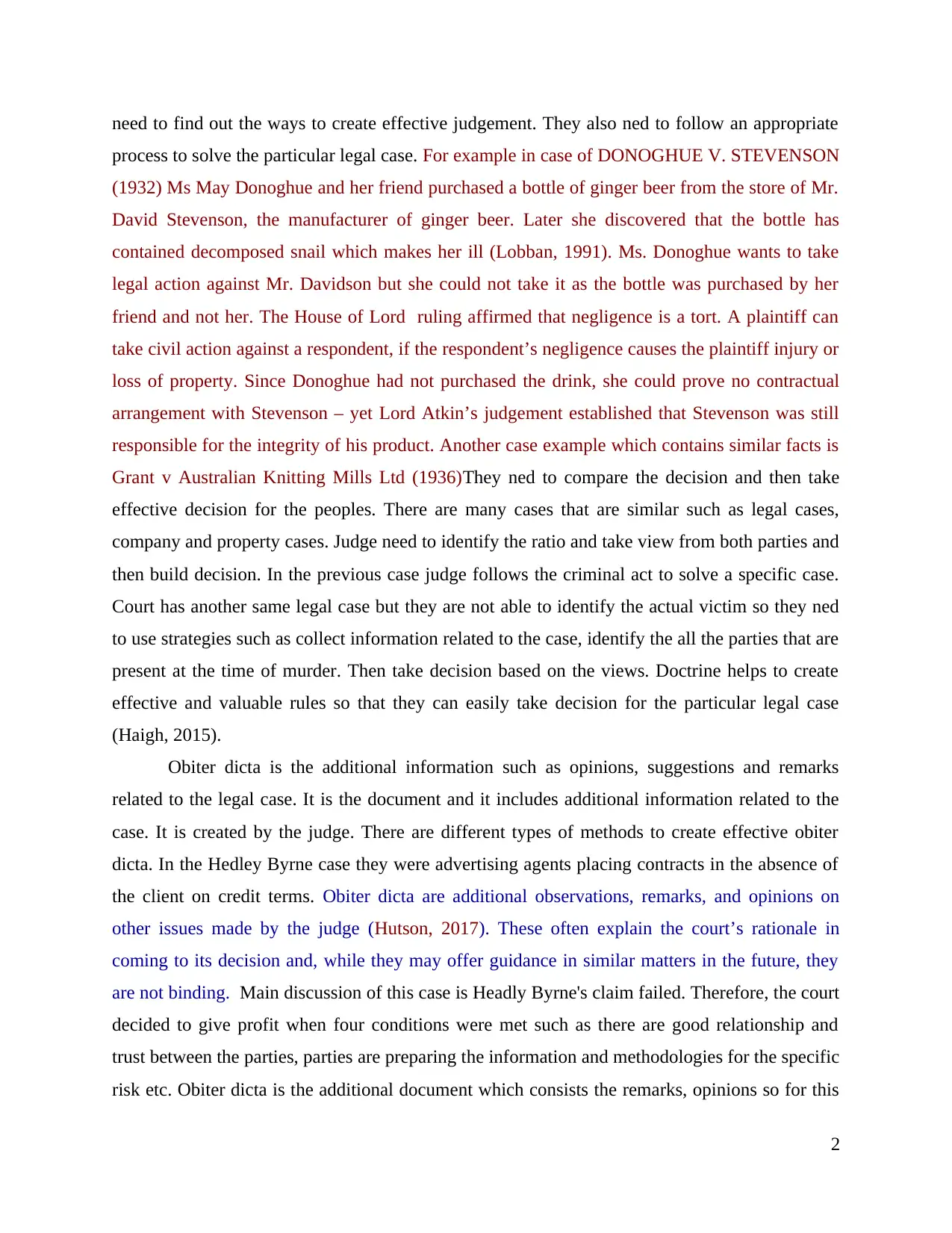
need to find out the ways to create effective judgement. They also ned to follow an appropriate
process to solve the particular legal case. For example in case of DONOGHUE V. STEVENSON
(1932) Ms May Donoghue and her friend purchased a bottle of ginger beer from the store of Mr.
David Stevenson, the manufacturer of ginger beer. Later she discovered that the bottle has
contained decomposed snail which makes her ill (Lobban, 1991). Ms. Donoghue wants to take
legal action against Mr. Davidson but she could not take it as the bottle was purchased by her
friend and not her. The House of Lord ruling affirmed that negligence is a tort. A plaintiff can
take civil action against a respondent, if the respondent’s negligence causes the plaintiff injury or
loss of property. Since Donoghue had not purchased the drink, she could prove no contractual
arrangement with Stevenson – yet Lord Atkin’s judgement established that Stevenson was still
responsible for the integrity of his product. Another case example which contains similar facts is
Grant v Australian Knitting Mills Ltd (1936)They ned to compare the decision and then take
effective decision for the peoples. There are many cases that are similar such as legal cases,
company and property cases. Judge need to identify the ratio and take view from both parties and
then build decision. In the previous case judge follows the criminal act to solve a specific case.
Court has another same legal case but they are not able to identify the actual victim so they ned
to use strategies such as collect information related to the case, identify the all the parties that are
present at the time of murder. Then take decision based on the views. Doctrine helps to create
effective and valuable rules so that they can easily take decision for the particular legal case
(Haigh, 2015).
Obiter dicta is the additional information such as opinions, suggestions and remarks
related to the legal case. It is the document and it includes additional information related to the
case. It is created by the judge. There are different types of methods to create effective obiter
dicta. In the Hedley Byrne case they were advertising agents placing contracts in the absence of
the client on credit terms. Obiter dicta are additional observations, remarks, and opinions on
other issues made by the judge (Hutson, 2017). These often explain the court’s rationale in
coming to its decision and, while they may offer guidance in similar matters in the future, they
are not binding. Main discussion of this case is Headly Byrne's claim failed. Therefore, the court
decided to give profit when four conditions were met such as there are good relationship and
trust between the parties, parties are preparing the information and methodologies for the specific
risk etc. Obiter dicta is the additional document which consists the remarks, opinions so for this
2
process to solve the particular legal case. For example in case of DONOGHUE V. STEVENSON
(1932) Ms May Donoghue and her friend purchased a bottle of ginger beer from the store of Mr.
David Stevenson, the manufacturer of ginger beer. Later she discovered that the bottle has
contained decomposed snail which makes her ill (Lobban, 1991). Ms. Donoghue wants to take
legal action against Mr. Davidson but she could not take it as the bottle was purchased by her
friend and not her. The House of Lord ruling affirmed that negligence is a tort. A plaintiff can
take civil action against a respondent, if the respondent’s negligence causes the plaintiff injury or
loss of property. Since Donoghue had not purchased the drink, she could prove no contractual
arrangement with Stevenson – yet Lord Atkin’s judgement established that Stevenson was still
responsible for the integrity of his product. Another case example which contains similar facts is
Grant v Australian Knitting Mills Ltd (1936)They ned to compare the decision and then take
effective decision for the peoples. There are many cases that are similar such as legal cases,
company and property cases. Judge need to identify the ratio and take view from both parties and
then build decision. In the previous case judge follows the criminal act to solve a specific case.
Court has another same legal case but they are not able to identify the actual victim so they ned
to use strategies such as collect information related to the case, identify the all the parties that are
present at the time of murder. Then take decision based on the views. Doctrine helps to create
effective and valuable rules so that they can easily take decision for the particular legal case
(Haigh, 2015).
Obiter dicta is the additional information such as opinions, suggestions and remarks
related to the legal case. It is the document and it includes additional information related to the
case. It is created by the judge. There are different types of methods to create effective obiter
dicta. In the Hedley Byrne case they were advertising agents placing contracts in the absence of
the client on credit terms. Obiter dicta are additional observations, remarks, and opinions on
other issues made by the judge (Hutson, 2017). These often explain the court’s rationale in
coming to its decision and, while they may offer guidance in similar matters in the future, they
are not binding. Main discussion of this case is Headly Byrne's claim failed. Therefore, the court
decided to give profit when four conditions were met such as there are good relationship and
trust between the parties, parties are preparing the information and methodologies for the specific
risk etc. Obiter dicta is the additional document which consists the remarks, opinions so for this
2
⊘ This is a preview!⊘
Do you want full access?
Subscribe today to unlock all pages.

Trusted by 1+ million students worldwide
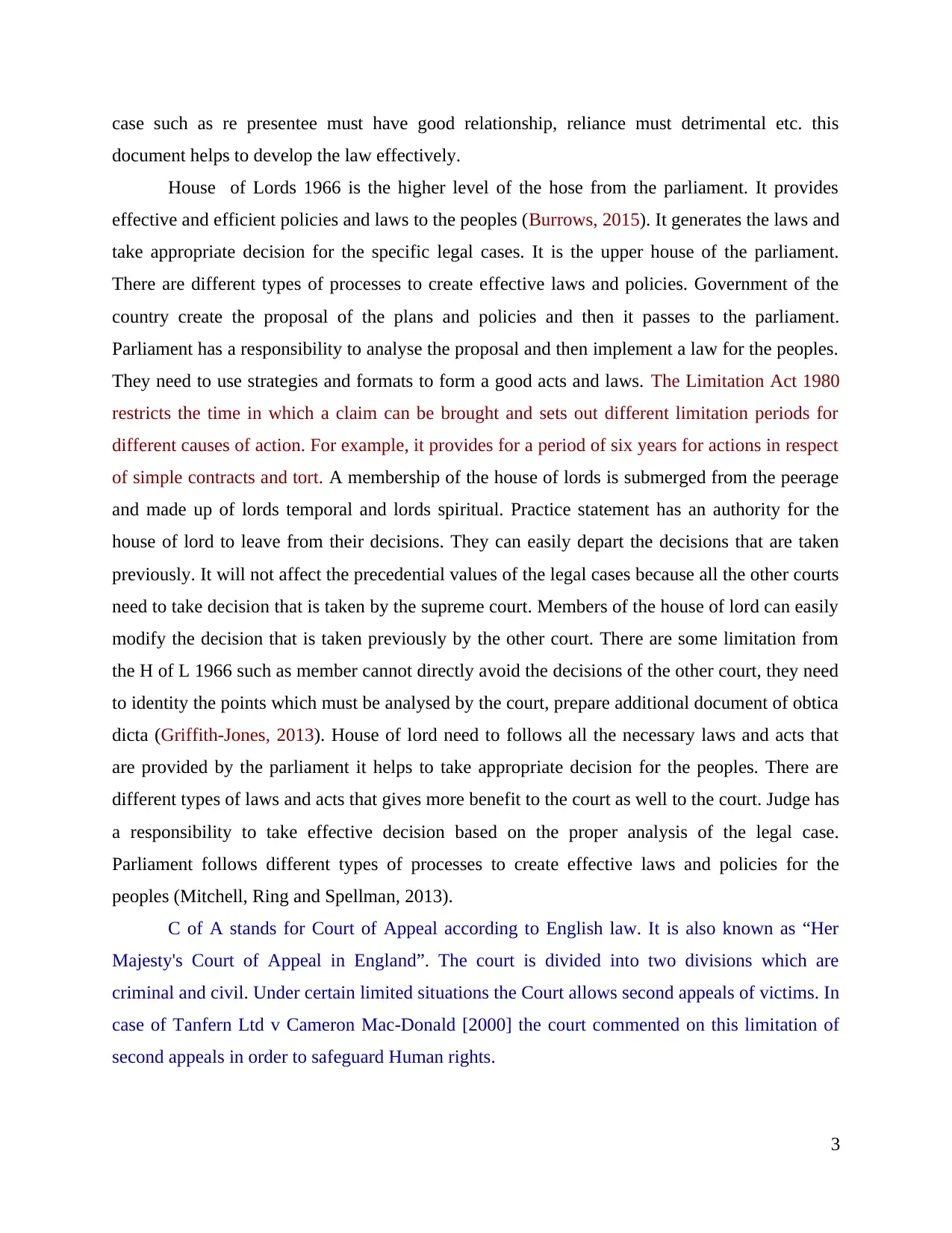
case such as re presentee must have good relationship, reliance must detrimental etc. this
document helps to develop the law effectively.
House of Lords 1966 is the higher level of the hose from the parliament. It provides
effective and efficient policies and laws to the peoples (Burrows, 2015). It generates the laws and
take appropriate decision for the specific legal cases. It is the upper house of the parliament.
There are different types of processes to create effective laws and policies. Government of the
country create the proposal of the plans and policies and then it passes to the parliament.
Parliament has a responsibility to analyse the proposal and then implement a law for the peoples.
They need to use strategies and formats to form a good acts and laws. The Limitation Act 1980
restricts the time in which a claim can be brought and sets out different limitation periods for
different causes of action. For example, it provides for a period of six years for actions in respect
of simple contracts and tort. A membership of the house of lords is submerged from the peerage
and made up of lords temporal and lords spiritual. Practice statement has an authority for the
house of lord to leave from their decisions. They can easily depart the decisions that are taken
previously. It will not affect the precedential values of the legal cases because all the other courts
need to take decision that is taken by the supreme court. Members of the house of lord can easily
modify the decision that is taken previously by the other court. There are some limitation from
the H of L 1966 such as member cannot directly avoid the decisions of the other court, they need
to identity the points which must be analysed by the court, prepare additional document of obtica
dicta (Griffith-Jones, 2013). House of lord need to follows all the necessary laws and acts that
are provided by the parliament it helps to take appropriate decision for the peoples. There are
different types of laws and acts that gives more benefit to the court as well to the court. Judge has
a responsibility to take effective decision based on the proper analysis of the legal case.
Parliament follows different types of processes to create effective laws and policies for the
peoples (Mitchell, Ring and Spellman, 2013).
C of A stands for Court of Appeal according to English law. It is also known as “Her
Majesty's Court of Appeal in England”. The court is divided into two divisions which are
criminal and civil. Under certain limited situations the Court allows second appeals of victims. In
case of Tanfern Ltd v Cameron Mac-Donald [2000] the court commented on this limitation of
second appeals in order to safeguard Human rights.
3
document helps to develop the law effectively.
House of Lords 1966 is the higher level of the hose from the parliament. It provides
effective and efficient policies and laws to the peoples (Burrows, 2015). It generates the laws and
take appropriate decision for the specific legal cases. It is the upper house of the parliament.
There are different types of processes to create effective laws and policies. Government of the
country create the proposal of the plans and policies and then it passes to the parliament.
Parliament has a responsibility to analyse the proposal and then implement a law for the peoples.
They need to use strategies and formats to form a good acts and laws. The Limitation Act 1980
restricts the time in which a claim can be brought and sets out different limitation periods for
different causes of action. For example, it provides for a period of six years for actions in respect
of simple contracts and tort. A membership of the house of lords is submerged from the peerage
and made up of lords temporal and lords spiritual. Practice statement has an authority for the
house of lord to leave from their decisions. They can easily depart the decisions that are taken
previously. It will not affect the precedential values of the legal cases because all the other courts
need to take decision that is taken by the supreme court. Members of the house of lord can easily
modify the decision that is taken previously by the other court. There are some limitation from
the H of L 1966 such as member cannot directly avoid the decisions of the other court, they need
to identity the points which must be analysed by the court, prepare additional document of obtica
dicta (Griffith-Jones, 2013). House of lord need to follows all the necessary laws and acts that
are provided by the parliament it helps to take appropriate decision for the peoples. There are
different types of laws and acts that gives more benefit to the court as well to the court. Judge has
a responsibility to take effective decision based on the proper analysis of the legal case.
Parliament follows different types of processes to create effective laws and policies for the
peoples (Mitchell, Ring and Spellman, 2013).
C of A stands for Court of Appeal according to English law. It is also known as “Her
Majesty's Court of Appeal in England”. The court is divided into two divisions which are
criminal and civil. Under certain limited situations the Court allows second appeals of victims. In
case of Tanfern Ltd v Cameron Mac-Donald [2000] the court commented on this limitation of
second appeals in order to safeguard Human rights.
3
Paraphrase This Document
Need a fresh take? Get an instant paraphrase of this document with our AI Paraphraser
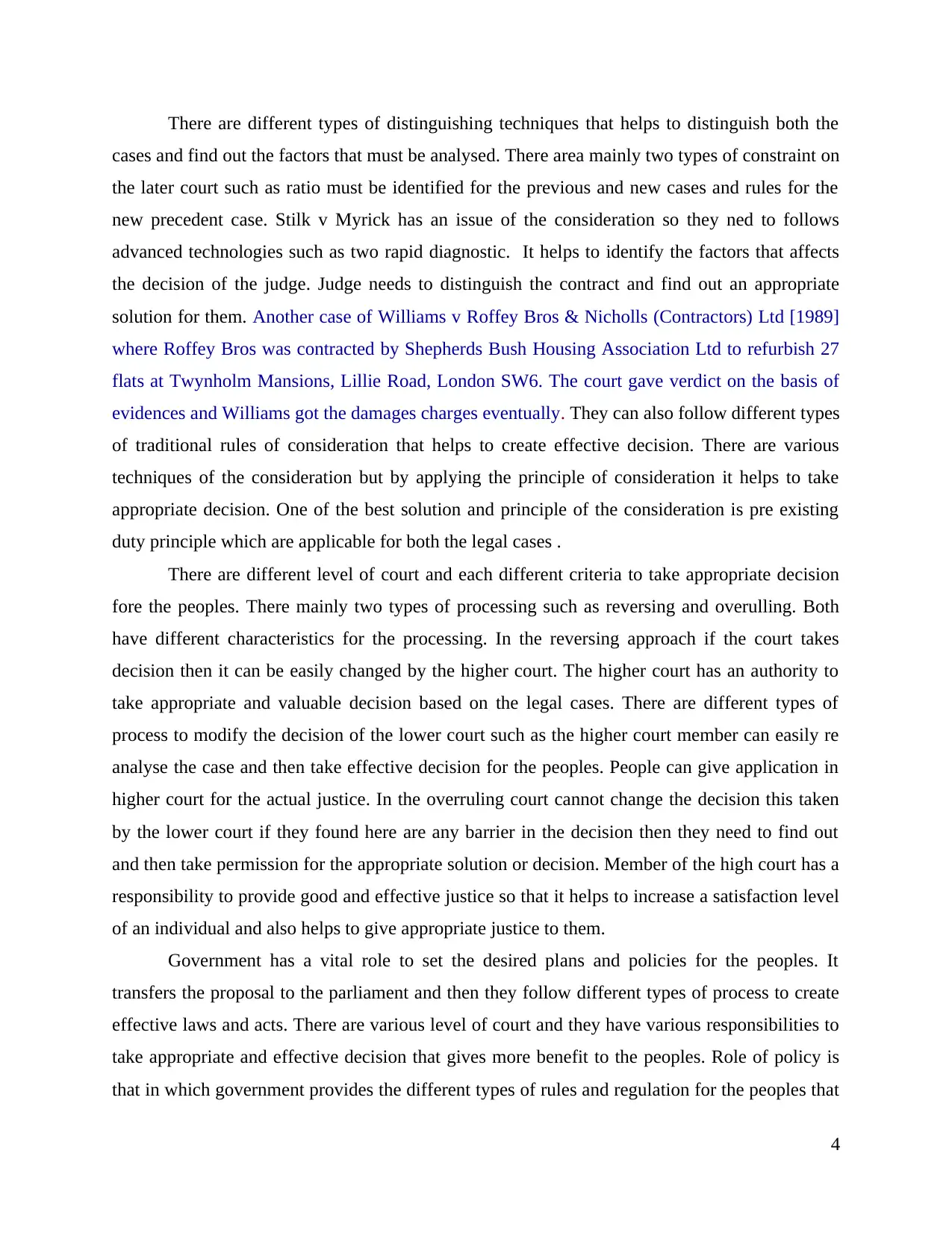
There are different types of distinguishing techniques that helps to distinguish both the
cases and find out the factors that must be analysed. There area mainly two types of constraint on
the later court such as ratio must be identified for the previous and new cases and rules for the
new precedent case. Stilk v Myrick has an issue of the consideration so they ned to follows
advanced technologies such as two rapid diagnostic. It helps to identify the factors that affects
the decision of the judge. Judge needs to distinguish the contract and find out an appropriate
solution for them. Another case of Williams v Roffey Bros & Nicholls (Contractors) Ltd [1989]
where Roffey Bros was contracted by Shepherds Bush Housing Association Ltd to refurbish 27
flats at Twynholm Mansions, Lillie Road, London SW6. The court gave verdict on the basis of
evidences and Williams got the damages charges eventually. They can also follow different types
of traditional rules of consideration that helps to create effective decision. There are various
techniques of the consideration but by applying the principle of consideration it helps to take
appropriate decision. One of the best solution and principle of the consideration is pre existing
duty principle which are applicable for both the legal cases .
There are different level of court and each different criteria to take appropriate decision
fore the peoples. There mainly two types of processing such as reversing and overulling. Both
have different characteristics for the processing. In the reversing approach if the court takes
decision then it can be easily changed by the higher court. The higher court has an authority to
take appropriate and valuable decision based on the legal cases. There are different types of
process to modify the decision of the lower court such as the higher court member can easily re
analyse the case and then take effective decision for the peoples. People can give application in
higher court for the actual justice. In the overruling court cannot change the decision this taken
by the lower court if they found here are any barrier in the decision then they need to find out
and then take permission for the appropriate solution or decision. Member of the high court has a
responsibility to provide good and effective justice so that it helps to increase a satisfaction level
of an individual and also helps to give appropriate justice to them.
Government has a vital role to set the desired plans and policies for the peoples. It
transfers the proposal to the parliament and then they follow different types of process to create
effective laws and acts. There are various level of court and they have various responsibilities to
take appropriate and effective decision that gives more benefit to the peoples. Role of policy is
that in which government provides the different types of rules and regulation for the peoples that
4
cases and find out the factors that must be analysed. There area mainly two types of constraint on
the later court such as ratio must be identified for the previous and new cases and rules for the
new precedent case. Stilk v Myrick has an issue of the consideration so they ned to follows
advanced technologies such as two rapid diagnostic. It helps to identify the factors that affects
the decision of the judge. Judge needs to distinguish the contract and find out an appropriate
solution for them. Another case of Williams v Roffey Bros & Nicholls (Contractors) Ltd [1989]
where Roffey Bros was contracted by Shepherds Bush Housing Association Ltd to refurbish 27
flats at Twynholm Mansions, Lillie Road, London SW6. The court gave verdict on the basis of
evidences and Williams got the damages charges eventually. They can also follow different types
of traditional rules of consideration that helps to create effective decision. There are various
techniques of the consideration but by applying the principle of consideration it helps to take
appropriate decision. One of the best solution and principle of the consideration is pre existing
duty principle which are applicable for both the legal cases .
There are different level of court and each different criteria to take appropriate decision
fore the peoples. There mainly two types of processing such as reversing and overulling. Both
have different characteristics for the processing. In the reversing approach if the court takes
decision then it can be easily changed by the higher court. The higher court has an authority to
take appropriate and valuable decision based on the legal cases. There are different types of
process to modify the decision of the lower court such as the higher court member can easily re
analyse the case and then take effective decision for the peoples. People can give application in
higher court for the actual justice. In the overruling court cannot change the decision this taken
by the lower court if they found here are any barrier in the decision then they need to find out
and then take permission for the appropriate solution or decision. Member of the high court has a
responsibility to provide good and effective justice so that it helps to increase a satisfaction level
of an individual and also helps to give appropriate justice to them.
Government has a vital role to set the desired plans and policies for the peoples. It
transfers the proposal to the parliament and then they follow different types of process to create
effective laws and acts. There are various level of court and they have various responsibilities to
take appropriate and effective decision that gives more benefit to the peoples. Role of policy is
that in which government provides the different types of rules and regulation for the peoples that
4
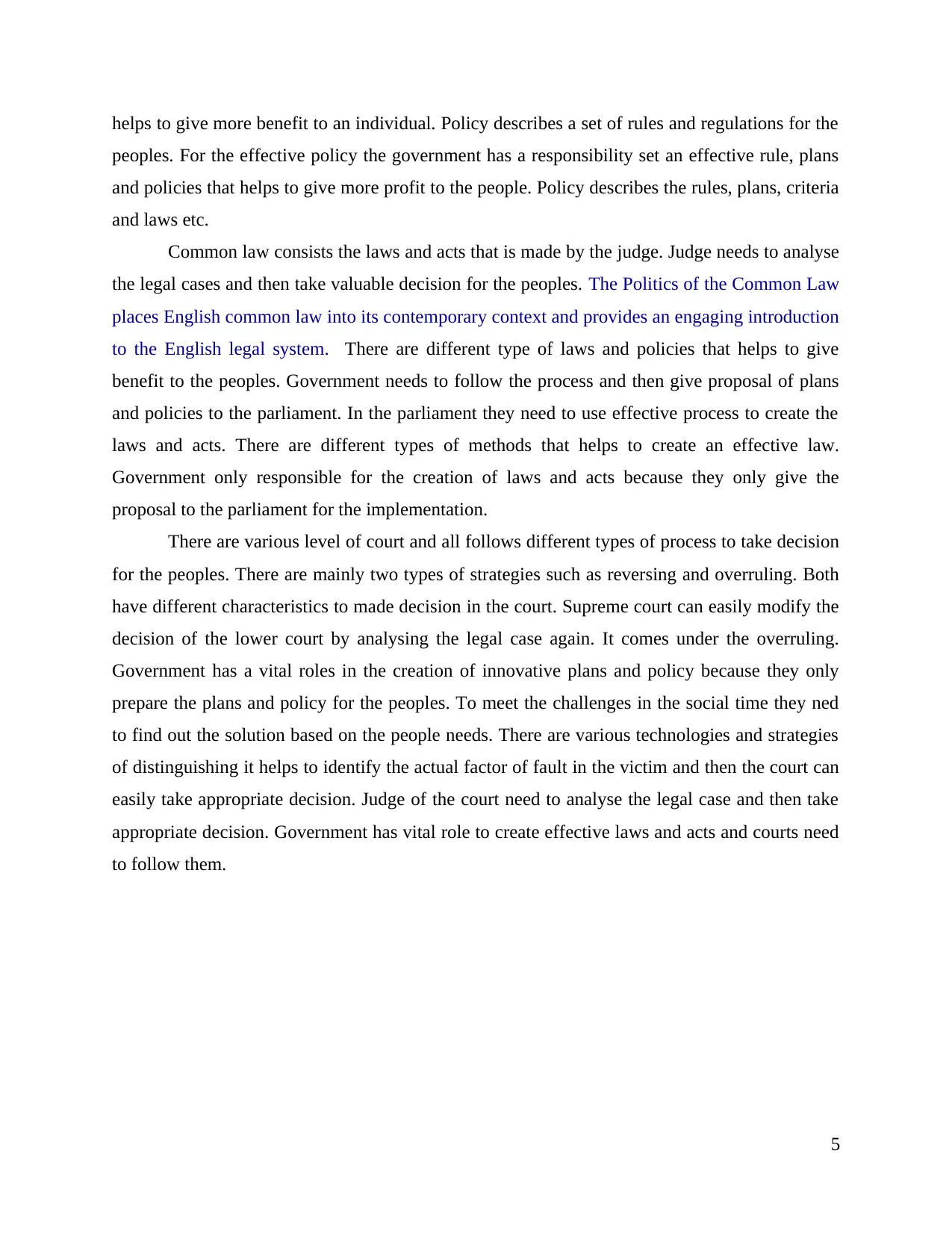
helps to give more benefit to an individual. Policy describes a set of rules and regulations for the
peoples. For the effective policy the government has a responsibility set an effective rule, plans
and policies that helps to give more profit to the people. Policy describes the rules, plans, criteria
and laws etc.
Common law consists the laws and acts that is made by the judge. Judge needs to analyse
the legal cases and then take valuable decision for the peoples. The Politics of the Common Law
places English common law into its contemporary context and provides an engaging introduction
to the English legal system. There are different type of laws and policies that helps to give
benefit to the peoples. Government needs to follow the process and then give proposal of plans
and policies to the parliament. In the parliament they need to use effective process to create the
laws and acts. There are different types of methods that helps to create an effective law.
Government only responsible for the creation of laws and acts because they only give the
proposal to the parliament for the implementation.
There are various level of court and all follows different types of process to take decision
for the peoples. There are mainly two types of strategies such as reversing and overruling. Both
have different characteristics to made decision in the court. Supreme court can easily modify the
decision of the lower court by analysing the legal case again. It comes under the overruling.
Government has a vital roles in the creation of innovative plans and policy because they only
prepare the plans and policy for the peoples. To meet the challenges in the social time they ned
to find out the solution based on the people needs. There are various technologies and strategies
of distinguishing it helps to identify the actual factor of fault in the victim and then the court can
easily take appropriate decision. Judge of the court need to analyse the legal case and then take
appropriate decision. Government has vital role to create effective laws and acts and courts need
to follow them.
5
peoples. For the effective policy the government has a responsibility set an effective rule, plans
and policies that helps to give more profit to the people. Policy describes the rules, plans, criteria
and laws etc.
Common law consists the laws and acts that is made by the judge. Judge needs to analyse
the legal cases and then take valuable decision for the peoples. The Politics of the Common Law
places English common law into its contemporary context and provides an engaging introduction
to the English legal system. There are different type of laws and policies that helps to give
benefit to the peoples. Government needs to follow the process and then give proposal of plans
and policies to the parliament. In the parliament they need to use effective process to create the
laws and acts. There are different types of methods that helps to create an effective law.
Government only responsible for the creation of laws and acts because they only give the
proposal to the parliament for the implementation.
There are various level of court and all follows different types of process to take decision
for the peoples. There are mainly two types of strategies such as reversing and overruling. Both
have different characteristics to made decision in the court. Supreme court can easily modify the
decision of the lower court by analysing the legal case again. It comes under the overruling.
Government has a vital roles in the creation of innovative plans and policy because they only
prepare the plans and policy for the peoples. To meet the challenges in the social time they ned
to find out the solution based on the people needs. There are various technologies and strategies
of distinguishing it helps to identify the actual factor of fault in the victim and then the court can
easily take appropriate decision. Judge of the court need to analyse the legal case and then take
appropriate decision. Government has vital role to create effective laws and acts and courts need
to follow them.
5
⊘ This is a preview!⊘
Do you want full access?
Subscribe today to unlock all pages.

Trusted by 1+ million students worldwide
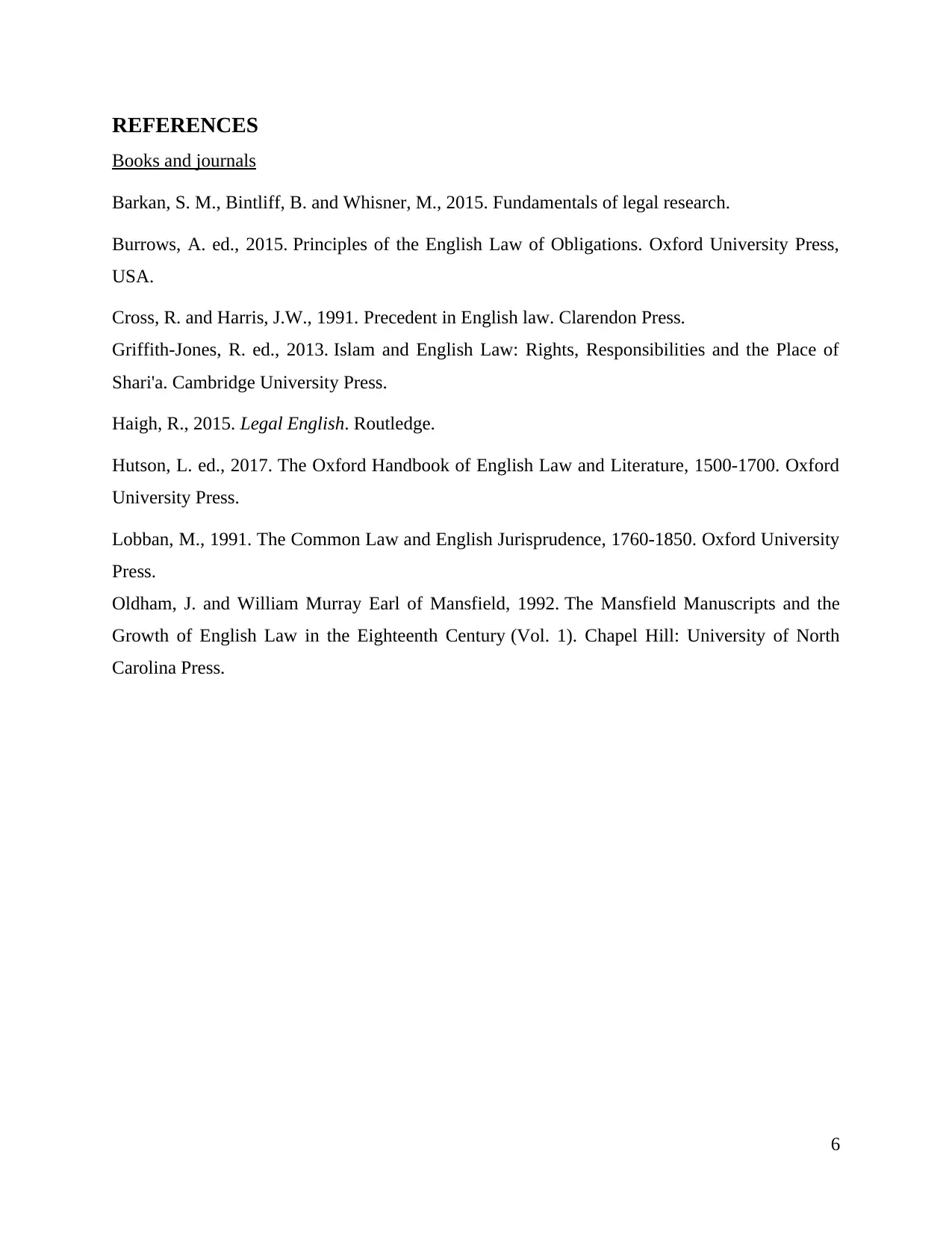
REFERENCES
Books and journals
Barkan, S. M., Bintliff, B. and Whisner, M., 2015. Fundamentals of legal research.
Burrows, A. ed., 2015. Principles of the English Law of Obligations. Oxford University Press,
USA.
Cross, R. and Harris, J.W., 1991. Precedent in English law. Clarendon Press.
Griffith-Jones, R. ed., 2013. Islam and English Law: Rights, Responsibilities and the Place of
Shari'a. Cambridge University Press.
Haigh, R., 2015. Legal English. Routledge.
Hutson, L. ed., 2017. The Oxford Handbook of English Law and Literature, 1500-1700. Oxford
University Press.
Lobban, M., 1991. The Common Law and English Jurisprudence, 1760-1850. Oxford University
Press.
Oldham, J. and William Murray Earl of Mansfield, 1992. The Mansfield Manuscripts and the
Growth of English Law in the Eighteenth Century (Vol. 1). Chapel Hill: University of North
Carolina Press.
6
Books and journals
Barkan, S. M., Bintliff, B. and Whisner, M., 2015. Fundamentals of legal research.
Burrows, A. ed., 2015. Principles of the English Law of Obligations. Oxford University Press,
USA.
Cross, R. and Harris, J.W., 1991. Precedent in English law. Clarendon Press.
Griffith-Jones, R. ed., 2013. Islam and English Law: Rights, Responsibilities and the Place of
Shari'a. Cambridge University Press.
Haigh, R., 2015. Legal English. Routledge.
Hutson, L. ed., 2017. The Oxford Handbook of English Law and Literature, 1500-1700. Oxford
University Press.
Lobban, M., 1991. The Common Law and English Jurisprudence, 1760-1850. Oxford University
Press.
Oldham, J. and William Murray Earl of Mansfield, 1992. The Mansfield Manuscripts and the
Growth of English Law in the Eighteenth Century (Vol. 1). Chapel Hill: University of North
Carolina Press.
6
1 out of 7
Related Documents
Your All-in-One AI-Powered Toolkit for Academic Success.
+13062052269
info@desklib.com
Available 24*7 on WhatsApp / Email
![[object Object]](/_next/static/media/star-bottom.7253800d.svg)
Unlock your academic potential
Copyright © 2020–2025 A2Z Services. All Rights Reserved. Developed and managed by ZUCOL.





